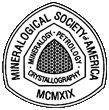 |
The Mineral Identification Key |  |
 |
The Mineral Identification Key |  |
Table IIB-2: Streak Not Colored, Cleavage Not Prominent, Hardness less than 2½: (Can be scratched with a fingernail; Streak: white or none; Cleavage absent or not obvious.) [Previous Table] [Next Table]
| Hardness | Color | Luster | Cleavage | Name | System | Habit | SG | Notes |
| 1 to 2 | Colorless to White (may be stained by impurities) | Vitreous to sub- vitreous | Imperfect in four directions (octahedral), may not be seen | SAL AMMONIAC NH4Cl |
Isometric | Usually as powdery crusts around volcanic-vents or in coal seams that have burned, crystals usually trapezohedral, tiny, in skeletal or dendritic aggregates | 1.53 | May also be gyroidal or dodecahedral (rarely), very plastic; difficult to determine hardness, tastes stingingly salty. Rare. |
| 1 | White to Colorless |
Perfect in one direction, may not be seen | ULEXITE NaCaB5O6(OH).5H2O |
Triclinic | Usually as masses of fibrous or fine acicular crystals, rounded | 1.95 | Specimens with clear ends placed on print transmit the image through the sample – you can read through it. "TV-stone". | |
| 1½ to 2 | Colorless to White or Grey | Vitreous to sub-vitreous | Perfect in one direction, good in one direction, poor in one direction (rhombohedral), may not be apparent | NITRATINE (Nitratite, Soda-Niter) NaNO3 |
Trigonal | Usually massive, granular, crystals rhombohedral | 2.24 to 2.29 | White streak; easily dissolved in water, luster, has a cooling and salty taste, easily fusible in a candle flame; Natratine and Niter are difficult to distinguish from one another without tests for Na and K |
| Hardness | Color | Luster | Cleavage | Name | System | Habit | SG | Notes |
| 1 to 2 | White, Pale pink, Buff, Yellow, Red, Green | Dull to earthy | Perfect in one direction, probably will not be seen | MONTMORILLONITE |
Monoclinic | Usually as compact earthy masses | 2-3 | Earthy odor when moistened |
| 1½ to 2½ | Bright-yellow | Resinous to sub- vitreous, may appear somewhat earthy when massive or as crusts | Imperfect in three directions (rhombic), may not be apparent | SULFUR S |
Orthorhombic | Usually imperfectly crystallized masses or crusts | 2.05 to 2.09 | Usually gives a pale-yellow streak, readily burns in a candle flame giving a blue flame |
| 2 | Colorless to White or Grey | Vitreous to sub-vitreous | Perfect in one direction, imperfect in one direction, good in one direction (prismatic), may not be apparent | NITER (Saltpeter) KNO3 |
Orthorhombic | Usually as thin crusts, granular to powdery, massive, or columnar, may be in silky tufts or delicate acicular crystals | 2.10 | White streak; easily dissolved in water, has a cooling and salty taste, easily fusible in a candle flame; Natratine and niter are difficult to distinguish from one another without tests for Na and K |
| 2 to 2½ | White to Tan, may be Greyish | Earthy | Perfect in one direction, probably will not be seen | KAOLINITE Al2Si2O5(OH)4 |
Triclinic | Usually as compact earthy masses | 2.6 | Earth odor when moistened, sticks to a dry tongue |
| Hardness | Color | Luster | Cleavage | Name | System | Habit | SG | Notes |
| 2 to 2½ | Bright-red to Pale-rose | Vitreous to sub-vitreous | Perfect in three directions (cubic), may not be seen | VILLIAUNITE NaF |
Isometric | Usually as small to tiny cubic crystals, sometimes modified by the octahedron, also as cleavable masses (small?), granular | 2.79 | White streak; dissolves in water: very poisonous! Rare. |
| 2½ | White to Colorless, Greyish, to Yellowish or Tannish | Vitreous to waxy luster, may be dull. | Perfect in one direction, may not be seen | COOKEITE (Chlorite Group) |
Monoclinic | Usually as aggregates of tiny flakes or scales, crystals in tiny rosettes or spherical radiating clusters, may be somewhat botryoidal looking, flakes or scales elastic | 2.58 to 2.69 | Flakes or scales elastic |
Note: There are very few common to rare non-metallic species less than 2½ in hardness which do not have at least one good cleavage. Any sample that keys out to this point and is not one of the above listed minerals needs to be re-examined. It probably either has a prominent cleavage or is harder than 2½. Or it is a very rare to extremely rare species not covered here.
[ Table of Contents ] [ Introduction ] [ Identification Kit ] [ Mineral Properties ] [ Environments & Associations ] [ In Conclusion ] [ The Mineral ID Key ]
[Previous Table] [
Next Table]